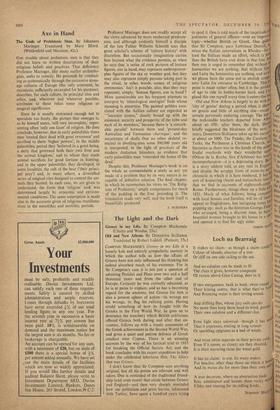Axe in Hand
The Gods of Prehistoric Man. By Johannes Maringer. Translated by Mary Ilford. (Weidenfeld and Nicolson, 42s.)
ONE trouble about prehistoric men is that they did not leave us written descriptions of their religious beliefs and practices. That deficiency Professor Malinger, like many earlier archeolo- gists. seeks to remedy. He proceeds by conduct- ing us systematically through the successive stone- age cultures of Europe (the only continent, he maintains, sufficiently excavated for his purpose); describes, for each culture, its principal sites and relics, and, wherever and whenever possible, attributes to those relics some religious or magical significance.
Since he is usually restrained enough not to speculate too freely, the picture that emerges is, as he himself states, 'still very incomplete,' repre- senting often 'only one facet' of religion. He does conclude, however, that in early palzeolithic times men 'treated their dead with great reverence' and ascribed to them 'higher powers'; in the middle palzeolithic period they 'believed in a great being, a deity that governed both their own lives and the animal kingdom,' and to whom they made animal sacrifices for good fortune in hunting; and in the upper palzeolithic they developed, in some localities, the cult of the bear ('their princi- pal prey') and, in many others, a diversified series of magical rites designed to control the ani- mals they hunted. In each case, we are given to understand, the form that 'religion' took was determined largely by economic and environ- mental conditions. The same assumption is made also in the accounts given of religious manifesta- tions in the mesolithic and neolithic periods.
Professor Maringer does not readily accept all the views advanced by more exuberant predeces- sors, and although evidently himself a disciple of the late Father Wilhelm Schmidt uses that great scholar's scheme of 'culture history' with discretion. But occasionally imagination carries him beyond what the evidence permits, as when he says that 'a series of rock pictures of human figures, axe in hand, may represent anthropomor- phic figures of the sky or weather god, but they may also represent simply persons taking part in the ritual, in other words, scenes of religious ceremonies.' Isn't it possible, also, that they may represent, simply, 'human figures, axe in hand'? More questionable are his frequent attempts to interpret by 'ethnological analogies' finds whose meaning is uncertain. The painted pebbles asso- ciated with the Azilian culture are regarded as '"ancestor stones," -closely bound up with the existence, security and prosperity of the tribe and each of its members,' because there is 'a remark- able parallel' between them and 'present-day Australian and Tasmanian charingas% and the occurrence of skulls (but no other skeletal re- mains) in dwelling-sites some 300,000 years old is interpreted, in the light of practices of the modern Andaman Islanders, as evidence that early palteolithic man 'venerated the bones of the dead.'
Despite this, Professor Maringer's book is on the whole as commendable a study as any yet made of a problem that by its very nature is in- capable of definitive solution. The final chapter, in which he summarises his views on `The Relig- ions of Prehistory,' amply compensates for much of the padding in the four preceding it. The translation reads very well, and the book itself is beautifully produced.
I. SCHAPERA


































 Previous page
Previous page